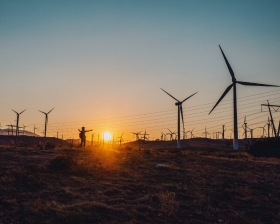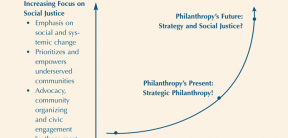You are here
Digging Out of Philanthropy’s Entrenched Practices

The philanthropic sector in the United States has, since the rise of industrialization at the turn of the 19th century, grappled with how to do more to improve society, do the work better, and achieve lasting results. And yet, philanthropy’s “operating system” itself has been a major impediment to progress: power dynamics, competitiveness, linear thinking, a demand for short-term results, working in silos, desire for attribution, and a lack of transparency all create conditions that make real change difficult at best. The Garfield Foundation isn’t immune to these aspects of our sector, however, we have been keen to find a way around these core challenges in order to unleash the impact we know is possible. As a result, 16 years ago we made an explicit commitment to experimenting with new ways of working that might help mitigate these constraining tendencies. Together as staff, trustees and advisors, we began asking ourselves questions like:
- Why aren’t our grantees who are working on similar challenges in deeper dialogue with one another?
- How might we more fully understand the root causes and complexity of the problems we hope to solve?
- How might we combine or align resources with other funders to embolden our grant-making, instead of keeping our grant-making behind closed doors?
- What can we learn by sitting with grantees and other funders at the same table to understand the complexity of the systems we are trying to shift?
- What practices might incentivize collaboration and collective action — between grantees, between funders, and between grantees and funders?
The RE-AMP Network
Motivated by these questions, in 2004 we identified a group of 20 willing leaders from both foundations and environmental advocacy organizations who agreed to come together to experiment with systems mapping to better understand the system we collectively seek to change. The system in question was the electricity sector in the Midwest, and our collective intent was to understand what was holding back the advancement of renewable energy versus carbon-laden energy such as coal. The nonprofits and foundations that participated in the Renewable Energy Alignment Mapping Project (RE-AMP) all worked on similar issues in the Midwest, but each organization had its own programs and mostly didn’t know what the other organizations were doing — certainly not what others were doing across state lines.
Garfield’s hunch was that we could use systems thinking to create alignment and support better collaboration among participating organizations. The systems mapping process unfolded over the course of a year, and, frankly, it was a difficult journey. It was hard work, time-consuming and required faith that the process would yield a useful outcome. Even so, each step of the process uncovered some intriguing insight that kept the participants curious and engaged. By the end of the year, the group had co-created a complex systems map, collectively identified a set of interventions informed by the map, solidified relationships, and decided unanimously to work together to deploy collaborative strategies that would advance renewable energy and stop the advancement of climate change. The RE-AMP Network was born. What started with 20 curious leaders is today a systems-informed collaborative network with more than 130 member organizations working across eight Midwestern states. Perhaps more importantly, it drove strategies and supported collaboration that contributed to the following achievements:
- An increase in wind and solar energy by 1142% since 2005 (that’s 26,325 MW of installed wind and solar capacity, enough to power nearly seven million homes)
- 2448 miles of new, high voltage transmission lines built or to-be-built predominantly in service to renewable energy
- Stopped the Midwest Coal Rush — over 200 coal-fired power plants retired or slated for retirement
The Cancer Free Economy Network
At the Garfield Foundation, we never lost sight of those fundamental questions that first drove us to embark on our journey with RE-AMP. As the RE-AMP Network gained momentum and evidence of impact, we became curious about the extent to which its systems-informed collaborative approach would be effective in another issue area. So in 2013, the Garfield Foundation issued a specific request for proposals for another group of collaborators keen to replicate and build on RE-AMP’s systems-informed collaborative network model. We received a staggering 62 inquiries having expected only a few, and in 2014 we began supporting and advising the new Cancer Free Economy Network (CFEN).
While the steps for creating the CFE Network — systems mapping and analysis, facilitated strategic planning, coordinated collaborative actions, development of network governance and infrastructure, et cetera — were comparable to RE-AMP, the issue of cancer-causing toxins, the national scope, the diversity of participant organizations, and the group dynamics were very different from what we had experienced with RE-AMP. What was similar was the determination and commitment of the leaders, the depth of relationships developed, and the insights that emerged at every step of the development of the network. While CFEN is still quite “young,” it is now a fully activated systems-informed network with 70 active members representing over 40 organizations. To date, CFEN collaborations have contributed to numerous developments across the system, including:
- Moving cancer research agendas closer toward a focus on primary prevention
- Training frontline communities to advocate for less toxic living and working conditions
- Supporting advocates of state-level regulation of cancer-causing chemicals
- Supporting business to adopt more robust chemical safety policies.
With 15 years of experience in our rearview, the Garfield Foundation is convinced that systems-informed collaboration is a solid strategy for understanding and shifting the root causes of complex problems and, ultimately, creating healthier outcomes for people and the planet. As such, we believe that a systems approach is essential to impactful grantmaking. What we are learning is that approaching social change through this perspective requires:
- Providing adequate space and time for building generative, trusting relationships
- Noticing and appreciating differences while nurturing constructive conversations
- Building the capacity for self-reflection to recognize our own blind spots
- Sharing power in order to grow power
- Leaning into long-term thinking
- Reflecting on emerging insights and adapting to changing conditions
On the ground, which is to say, in the grant-making boiler room, prioritizing these practices and more is essentially what we’re doing to overcome the constraints of business as usual.
The Garfield Foundation is committed not only to the two networks we helped found — they are our greatest source of learning! — but also to building the field of systems-informed collaboration. We have expanded our Collaborative Networks Program to spread the work more widely and to share our experience and methods by collaborating with diverse organizations that are helping to build more systems change networks than we could possibly do on our own. We look forward to sharing our experience, and encouraging our network- and systems-thinking colleagues to do the same. We believe that in doing so we will get much closer to the sustainable and equitable world we wish to live in.
Jennie Curtis is the Executive Director of the Garfield Foundation.
This post originally appeared on Medium where additional Garfield Foundation blog posts can be read here.
From our Blog
Upcoming Events
|
Jul 16 2024 Zoom |
Jul 18 2024 Zoom |

